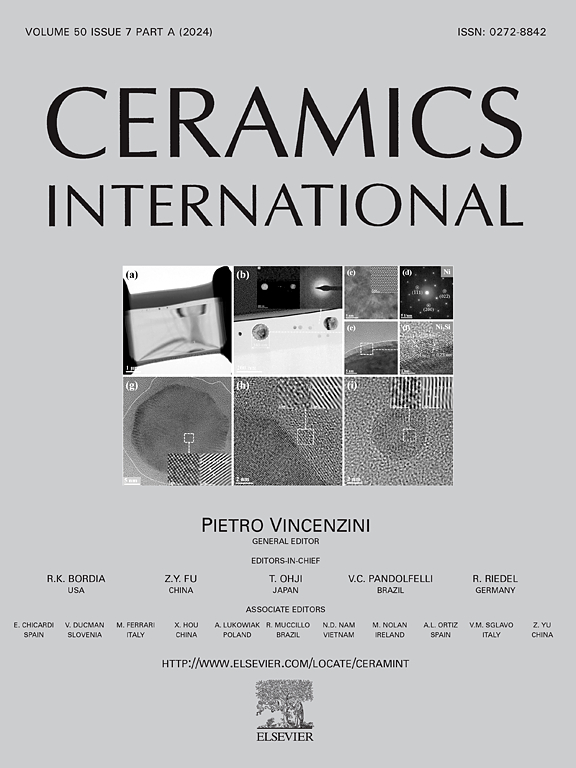Combined effect of refractory and refining slag on inclusions in tire cord steel
IF 5.1
2区 材料科学
Q1 MATERIALS SCIENCE, CERAMICS
引用次数: 0
Abstract
To understand the combined effect of refractory and refining slag on the inclusions in tire cord steels, steel grade LX72A was reacted with different MgO crucibles (impurity CaO <0.05 %; Al2O3 1.45 %–4.98 %) and different slags [basicity R = w(CaO)/w(SiO2), 0.6–1.0] in laboratory at 1550 °C, and the variation of the inclusion in steel was investigated. It was found that without slag, the MgO matrix and the impurities of Al2O3 and CaO in the crucibles would result in the increases of MgO, Al2O3 and CaO contents in inclusions. When the slags were employed, the increasing trend of MgO, Al2O3 and CaO contents in inclusions would be constrained by the slags, and lower slag basicity presented a stronger effect of containment. Besides, more Al2O3 impurities in crucibles cause a higher Al2O3 content in the inclusions. Two heats with different crucibles and slags may obtain close Al2O3 contents in the inclusions, e.g. (crucible Al2O3 4.98 % and slag R = 0.8) vs. (crucible Al2O3 2.77 % and slag R = 1.0). In this case, the combined effects of refractory and refining slag on the inclusions need to be considered. When the refractory contains relatively higher impurities, slag with lower basicity should be chosen. In contrast, relatively higher basicity can be considered in case of high refractory purity.
耐火材料和精炼渣对轮胎帘子线钢夹杂物的共同影响
为了解耐火渣和精炼渣对轮胎帘子线钢夹杂物的综合影响,采用不同的MgO坩埚(杂质CaO <; 0.05%;在1550℃的实验室条件下,研究了Al2O3(1.45% ~ 4.98%)和不同矿渣[碱度R = w(CaO)/w(SiO2), 0.6 ~ 1.0]在钢中夹杂物的变化。结果表明,在没有炉渣的情况下,坩埚中MgO基体和Al2O3、CaO杂质的存在会导致包裹体中MgO、Al2O3和CaO含量的增加。当炉渣加入时,夹杂物中MgO、Al2O3和CaO含量的增加趋势受到炉渣的约束,较低的炉渣碱度对夹杂物的遏制作用更强。坩埚中Al2O3杂质越多,导致包裹体中Al2O3含量越高。采用不同坩埚和炉渣的两种热处理可以获得相近的夹杂物Al2O3含量,例如(坩埚Al2O3为4.98%,炉渣R = 0.8)和(坩埚Al2O3为2.77%,炉渣R = 1.0)。在这种情况下,需要考虑耐火材料和精炼渣对夹杂物的综合影响。当耐火材料杂质含量较高时,应选用碱度较低的炉渣。相反,在耐火材料纯度高的情况下,可以考虑相对较高的碱度。
本文章由计算机程序翻译,如有差异,请以英文原文为准。
求助全文
约1分钟内获得全文
求助全文
来源期刊

Ceramics International
工程技术-材料科学:硅酸盐
CiteScore
9.40
自引率
15.40%
发文量
4558
审稿时长
25 days
期刊介绍:
Ceramics International covers the science of advanced ceramic materials. The journal encourages contributions that demonstrate how an understanding of the basic chemical and physical phenomena may direct materials design and stimulate ideas for new or improved processing techniques, in order to obtain materials with desired structural features and properties.
Ceramics International covers oxide and non-oxide ceramics, functional glasses, glass ceramics, amorphous inorganic non-metallic materials (and their combinations with metal and organic materials), in the form of particulates, dense or porous bodies, thin/thick films and laminated, graded and composite structures. Process related topics such as ceramic-ceramic joints or joining ceramics with dissimilar materials, as well as surface finishing and conditioning are also covered. Besides traditional processing techniques, manufacturing routes of interest include innovative procedures benefiting from externally applied stresses, electromagnetic fields and energetic beams, as well as top-down and self-assembly nanotechnology approaches. In addition, the journal welcomes submissions on bio-inspired and bio-enabled materials designs, experimentally validated multi scale modelling and simulation for materials design, and the use of the most advanced chemical and physical characterization techniques of structure, properties and behaviour.
Technologically relevant low-dimensional systems are a particular focus of Ceramics International. These include 0, 1 and 2-D nanomaterials (also covering CNTs, graphene and related materials, and diamond-like carbons), their nanocomposites, as well as nano-hybrids and hierarchical multifunctional nanostructures that might integrate molecular, biological and electronic components.
 求助内容:
求助内容: 应助结果提醒方式:
应助结果提醒方式:


